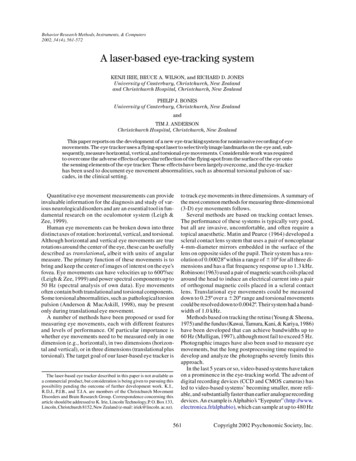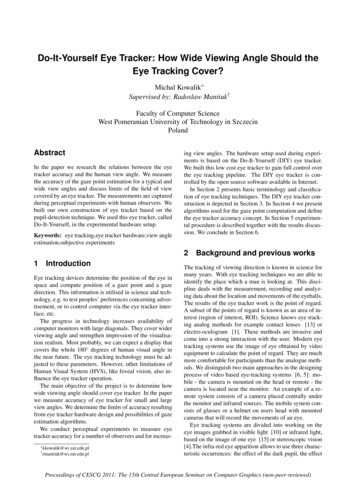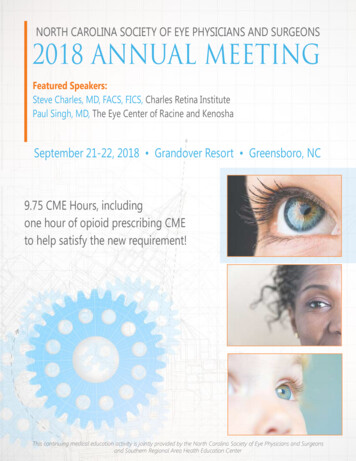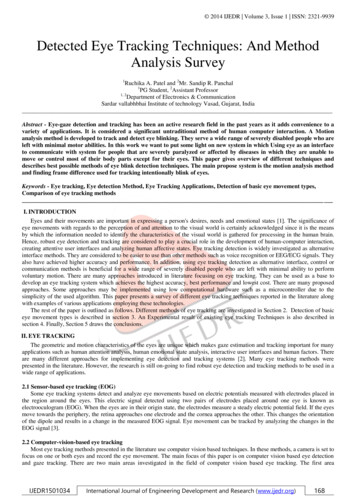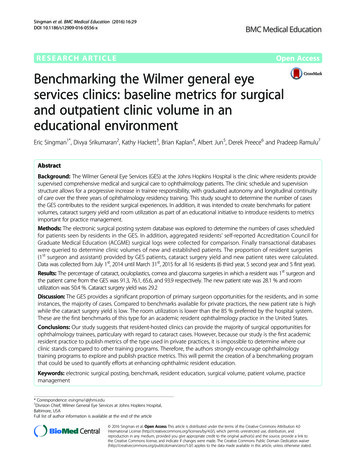
Transcription
Singman et al. BMC Medical Education (2016) 16:29DOI 10.1186/s12909-016-0556-xRESEARCH ARTICLEOpen AccessBenchmarking the Wilmer general eyeservices clinics: baseline metrics for surgicaland outpatient clinic volume in aneducational environmentEric Singman1*, Divya Srikumaran2, Kathy Hackett3, Brian Kaplan4, Albert Jun5, Derek Preece6 and Pradeep Ramulu7AbstractBackground: The Wilmer General Eye Services (GES) at the Johns Hopkins Hospital is the clinic where residents providesupervised comprehensive medical and surgical care to ophthalmology patients. The clinic schedule and supervisionstructure allows for a progressive increase in trainee responsibility, with graduated autonomy and longitudinal continuityof care over the three years of ophthalmology residency training. This study sought to determine the number of casesthe GES contributes to the resident surgical experiences. In addition, it was intended to create benchmarks for patientvolumes, cataract surgery yield and room utilization as part of an educational initiative to introduce residents to metricsimportant for practice management.Methods: The electronic surgical posting system database was explored to determine the numbers of cases scheduledfor patients seen by residents in the GES. In addition, aggregated residents’ self-reported Accreditation Council forGraduate Medical Education (ACGME) surgical logs were collected for comparison. Finally transactional databaseswere queried to determine clinic volumes of new and established patients. The proportion of resident surgeries(1st surgeon and assistant) provided by GES patients, cataract surgery yield and new patient rates were calculated.Data was collected from July 1st, 2014 until March 31st, 2015 for all 16 residents (6 third year, 5 second year and 5 first year).Results: The percentage of cataract, oculoplastics, cornea and glaucoma surgeries in which a resident was 1st surgeon andthe patient came from the GES was 91.3, 76.1, 65.6, and 93.9 respectively. The new patient rate was 28.1 % and roomutilization was 50.4 %. Cataract surgery yield was 29.2Discussion: The GES provides a significant proportion of primary surgeon opportunities for the residents, and in someinstances, the majority of cases. Compared to benchmarks available for private practices, the new patient rate is highwhile the cataract surgery yield is low. The room utilization is lower than the 85 % preferred by the hospital system.These are the first benchmarks of this type for an academic resident ophthalmology practice in the United States.Conclusions: Our study suggests that resident-hosted clinics can provide the majority of surgical opportunities forophthalmology trainees, particulary with regard to cataract cases. However, because our study is the first academicresident practice to publish metrics of the type used in private practices, it is impossible to determine where ourclinic stands compared to other training programs. Therefore, the authors strongly encourage ophthalmologytraining programs to explore and publish practice metrics. This will permit the creation of a benchmarking programthat could be used to quantify efforts at enhancing ophthalmic resident education.Keywords: electronic surgical posting, benchmark, resident education, surgical volume, patient volume, practicemanagement* Correspondence: esingma1@jhmi.edu1Division Chief, Wilmer General Eye Services at Johns Hopkins Hospital,Baltimore, USAFull list of author information is available at the end of the article 2016 Singman et al. Open Access This article is distributed under the terms of the Creative Commons Attribution 4.0International License (http://creativecommons.org/licenses/by/4.0/), which permits unrestricted use, distribution, andreproduction in any medium, provided you give appropriate credit to the original author(s) and the source, provide a link tothe Creative Commons license, and indicate if changes were made. The Creative Commons Public Domain Dedication o/1.0/) applies to the data made available in this article, unless otherwise stated.
Singman et al. BMC Medical Education (2016) 16:29BackgroundThe Wilmer General Eye Services (GES) at the JohnsHopkins Hospital (JHH) is the clinic where residentsprovide supervised care to comprehensive ophthalmology patients; the residents are encouraged to work witha significant degree of autonomy in this setting. Although the GES has been in service since 1925, it hasbeen an official division of Wilmer since 2011. At thattime, the GES was provided with an administrative teamheaded by a full time medical director and clinic manager whose responsibilities included identifying, trackingand optimizing the divisional educational contributionto resident training. In addition to these duties, the GESadministration was tasked with working closely with theWilmer residency program director and Wilmer ViceChair for Medical Education to enhance the training experience in the GES. Toward this end, the GES DivisionChief co-directed a program called the Resident Education Task Force (RETF), a Wilmer-wide effort initiated bythe chairman to evaluate resident education. The RETFidentified strengths to enhance and weaknesses to mitigateor eliminate, and then developed a system whereby theprocesses for improvement are continually monitored,evaluated and adjusted using specific metrics such as resident scores on the Ophthalmology Knowledge Assessment Profile (OKAP), surgical numbers for residents,numbers of publications and poster presentations, andresident satisfaction scores such as those mandated by theAccreditation Council for Graduate Medical Education(ACGME). One of the changes implemented by the RETFwas the creation of a Division Education Champion(DEC), a faculty member from each division who becameresponsible for clarifying, disseminating, implementingand monitoring the core competencies of that division,enabled by protected time and salary support. This approach had been suggested by the American Academy ofOphthalmology and the American Board of Ophthalmology [1]. The residency education committee was thenreformulated as the Program Evaluation Committee, consisting of the DECs as well as resident volunteers fromeach post-graduate year. The DECs were also instrumentalin directly improving the clinical experience in the GES byfacilitating the addition of specialty clinics running concurrently and co-located with the residents’ own comprehensive clinics. In academic year 2014–15, there wereGES clinics devoted to Oculoplastics, Glaucoma, AnteriorSegment/Cornea, Retina (laser, surgery and injections),Neuro-ophthalmology (specializing in traumatic brain injury), Pediatrics, Genetics and Optometry. In academicyear 2015–16, a clinic in uveitis will be added. The goal ofthese enhancements is to create a department-within-adivision model, ensuring that residents capture a wide variety of clinical and surgical opportunities by referringthem internally within the GES. Residents currently hostPage 2 of 7their comprehensive continuity clinic in the GES one dayeach week and then rotate in the GES specialty clinics orin attending-hosted clinics throughout the hospital system. There are opportunities to identify surgical cases inall of these venues.The DEC representing the GES division’s portfolio includes a mandate to demonstrate the educational impactof a clinic where residents are the chief providers of continuity care. In addition, the GES DEC is tasked to instructresidents in the profession of medicine, including but notlimited to coding, compliance, good charting habits, issuesrelated to patient satisfaction, delegation of care, understanding scope of practice, interactions with colleaguesacross divisions and departments, practice managementand ethics; these are all priorities described by the American Academy of Ophthalmology [2].Identifying a Wilmer Eye Institute faculty member tooversee the training of professionalism to residents maybe a unique approach, but it is aligned with the core competencies co-developed by the American Board of MedicalSpecialties (ABMS) and the Accreditation Council forGraduate Medical Education (ACGME) [3]. Indeed, a recent survey of ophthalmology residents themselves has indicated that training in aspects of professionalism, such aspractice management, could be enhanced [4]. Teachingprofessionalism to residents implies that they will developan understanding of some of the business processes andmetrics involved in practicing ophthalmology. The increasing complexity of the business environment and decreasing latitude in which healthcare dollars are spent addpriority to this task. Therefore it seems reasonable to support the educational mission of an academic outpatientophthalmology clinic by identifying, understanding, managing and teaching metrics such as clinic and surgical volumes. Although these metrics are important from afinancial perspective, they take on additional academic importance, since they can be used to introduce residents tothe process of practice management. This study, as part ofan ongoing effort to document the evolution of residentsurgical education at the Wilmer Eye Institute, sought toestablish key benchmarks that would be important to anyacademic ophthalmology outpatient clinic hosted by residents. To the authors’ knowledge, a study of this type hasnot been published for a United States academic outpatient ophthalmology clinic.MethodsData for this study were collected for the period betweenJuly 1, 2014 and March 31, 2015 for all 16 residents (6third year, 5 second year and 5 first year). Representativesurgical cases generated by patients visiting the WilmerGeneral Eye Services (GES) Clinic were gleaned fromthe surgical scheduling database by tracking CurrentProcedural Terminology (CPTTM) and Operating Room
Singman et al. BMC Medical Education (2016) 16:29Management Information System (ORMISTM) codes forpatients whose procedures were scheduled by a modifiedversion of the electronic surgical posting (e-posting)sheet. This modification permitted the physician scheduling a surgery to indicate whether the patient emanatedfrom the GES. The codes tracked by the e-posting systemare presented in Table 1. Although the case-lists extractedfrom the e-posting system contained patient names andmedical record numbers, they were visible only to thefaculty members overseeing the resident providers. Inaddition, resident surgical cases were gleaned from selfreported resident ACGME surgical logs. These logs contain no personal health information and were aggregatedfor the entire cohort of residents so that no individual resident’s data was available. Using these methods we wereable to identify virtually all surgical cases generated by theGES for residents during the time period noted.Clinic volumes were tracked using transactional analysisof hospital billing records. Benchmarks we analyzed include the contribution of GES patients to overall residentsurgical volumes, monthly and aggregate volumes of representative surgeries from the various ophthalmic subspecialties, proportion of new and established patient visits,proportion of cataract surgeries to new and total patientvisits, and room utilization.Room utilization was calculated based upon a hospitalwide formula which assumes that there are 251 clinicdays/year, the work day is 8 hours long, and maximumutilization is 1 patient/hour. The target for utilization is 85% at a maximum; the formula for utilization rate is: 100 xVa/Vm, where Va is the number of patient visits for theyear and Vm is 85 % of the maximum number of patientsthat can be seen in the clinic. Since the GES has 17 examination rooms (each hosting only one patient visit at anytime), the maximum number of patients that can be seenaccording to the hospital utilization formula is 17(rooms(i.e., patients)) x 251 (days/year) x 8 (hours/day) 34,136;85 % of that is 29,016 patients.This study has been approved by the JHH InstitutionalReview Board (IRB) as non-human subjects research; assuch, the need for consent was waived.ResultsTable 2 provides the numbers of surgeries tracked by theGES through the e-posting system (column 1) as well asthe numbers of surgeries logged by the residents themselves for cases during which the resident was the primarysurgeon (column2). Notably, the ACGME-resident logs areaggregated for the entire program and the case numbersare distributed across the corresponding CPT codes. Surgical subcategories that the DEC’s explored included procedures involving the cornea/anterior segment, glaucoma,oculoplastics/eyelid, pediatrics/strabismus, retina/vitreous,uveitis and cataract/intraocular lens. The third column ofPage 3 of 7the table shows the numbers of the resident logged-casesfiltered through those codes tracked by the GES. Many ofthe codes the DEC’s chose not to track were for proceduresthat would be expected to be performed on patients coming through the emergency department rather than theoutpatient clinic, particularly those related to trauma, including intra-ocular foreign bodies, ruptured globes, eyelidlacerations and orbital fractures. Column 4 shows the percentage of cases emanating from GES in which the residentwas first surgeon (value in column 1 divided by value incolumn 3). The highlighted results are those classes of surgeries where the GES contributed 2/3 or more of the totalresident surgical caseload. These include cornea/anteriorsegment, glaucoma, oculoplastics, uveitis and cataract/lens.The GES contributed more than 1/3 of the pediatrics/strabismus cases and nearly ½ of the retina/vitreous cases.During the study period, the numbers of new andestablished patient visits were 4114 and 10,512, respectively, and the ratio of new to total (14,626) patients was28.1 %. The ratios of GES-surgical cases to total patients,GES-cataract cases to new patients, and GES-cataractcases to total patients was 9.7 %, 12.2 %, and 5.8 % respectively. Room utilization, based upon the JHH standardwas 50.4 %. Finally, the no-show rate for the GES outpatient clinic averaged 22.1 % for the study period and thesame-day cancellation for the operating room used by ourpatients averaged 4 % during the study period.DiscussionThe key finding of this study is that the GES, a clinicwhere residents serve as primary providers for patients(with appropriate supervisory safeguards), provides residents with a substantial number of high quality (i.e., firstsurgeon as opposed to assistant) surgical opportunitiesin most of the major ophthalmic disciplines. Recognizingthat residents host their continuity clinic in the GESonly one day each week, it seems reasonable to suggestthat a resident clinic can be a viable source of significantsurgical volumes and therefore a worthwhile model forsurgical training. At present there are no other benchmarks to compare these data, and it may be useful tosurvey academic training sites to determine whetherthey host a clinic similar to the GES and if so, to queryhow their experiences compare.Benchmarking, i.e., comparing a specific measure to astandard or average, has received great emphasis by theAmerican Academy of Ophthalmology and it is now possible for a private practice to compare metrics such asfinancial performance and practice efficiency [5]. An international benchmarking initiative for eye hospitals waslaunched in 2001 and a report evaluating its progress waspublished in 2010 [6]. While the stakeholder hospitalsshowed very limited success in achieving the key conditions for benchmarking explored in the study, the exercise
Singman et al. BMC Medical Education (2016) 16:29Table 1 Representative Surgical Cases Tracked in e-posting forGES PatientsCodes format: CPT/ORMISCornea/Anterior Segment:66984/9574: extracapsular cataract extraction with intraocular lensimplantation65710/9480: keratoplasty lamellar65730/9585: keratoplasty (penetrating, phakic)65750/9445: keratoplasty (aphakia)65755/9446: keratoplasty (pseudophakia)65756/1242: keratoplasty (endothelial)65770/9377: keratoprosthesis65780/1096: amniotic membrane transplant65426/9438: excision pterygium with graftGlaucoma:66170/9349: trabeculectomy ab externo in absence of previoussurgery66172/9349: trabeculectomy ab externo with scarring fromprevious ocular surgery or trauma66180/9484: aqueous shunt to external reservoir66710/9566: Ciliary body destruction; cyclophotocoagulation66250/9590: revision or repair of operative wound of anteriorsegment, any type, early or late, major or minor procedureOculoplastics15823/4478: blepharoplasty21390/5842: Open therapy of orbital floor blowout fracture, transantralperiorbital approach with implant65105/8998: enucleation w/implant, muscles attached67840/9514: excision of lesion of eyelid (except chalazion) w/o closureor w/ simple direct closure67904/9437: external approach blepharoptosis repair, levator resection,Page 4 of 7Table 1 Representative Surgical Cases Tracked in e-posting forGES Patients (Continued)68816/9347: Probing of the nasolacrimal duct, with or withoutirrigation, with transluminal balloon catheter dilation66850/9573: Removal of lens material; phacofragmentation technique67010/9353: subtotal removal of vitreous with mechanical vitrectomyRetina:67113/9353: Repair of complex retinal detachment (eg, proliferativevitreoretinopathy, stage C-1 or greater, diabetic traction retinaldetachment, retinopathy of prematurity, retinal tear of greaterthan 90 degrees), with vitrectomy and membrane peeling, mayinclude air, gas, or silicone oil and/or removal of lens67108/9353: Repair of retinal detachment; with vitrectomy, anymethod, with or without air or gas tamponade, focal endolaserphotocoagulation, cryotherapy, drainage of subretinal fluid, scleralbuckling, and/or removal of lens by same technique67042/9353: Vitrectomy, mechanical, pars plana approach withremoval of internal limiting membrane of retina (eg, for repair ofmacular hole, diabetic macular edema), includes, if performed,intraocular tamponade (i.e., air, gas, silicone oil)67107/9353: Repair of retinal detachment; scleral buckling67040/9353: Vitrectomy, mechanical, pars plana approach; withendolaser panretinal photocoagulation67041/9353: Vitrectomy, mechanical, pars plana approach; withremoval of preretinal cellular membrane67039/9353: Vitrectomy, mechanical, pars plana approach; withfocal endolaser photocoagulation67036/9353: Vitrectomy, mechanical, pars plana approachUveitis:66982/9360: complex cataract requiring devices or techniques notgenerally used in routine cataract surgery (eg., iris expansiondevice, suture support for IOL, primary posterior capsulorrhexis) orperformed in patients in the amblyogenic developmental stage67027/9364: implantation of intravitreal drug delivery system(RetisertTM, VitrasertTM, OzurdexTM)67916/9539: repair of ectropion, excision tarsal wedge67917/9539: extensive tarsal strip operation67924/9538: tarsal strip or capsulopalpebral fascia repairs operation67930/9515: Suture of recent wound, eyelid, involving lid margin,tarsus, and/or palpebral conjunctiva direct closure; partialthickness67935/9515: Suture of recent wound, eyelid, involving lidmargin, tarsus, and/or palpebral conjunctiva direct closure; fullthickness68720/9542: Dacryocystorhinostomy (fistulization of lacrimal sac tonasal cavity)Pediatrics/Strabismus:67311–67335 inclusive/8986:i. 67311 one horizontal muscleii. 67312 two horizontal musclesiii. 67314 one vertical muscle except superior obliqueiv. 67316 two or more vertical muscles except superior obliquev. 67318 superior oblique68815/9347: probing of nasolacrimal duct, with or withoutirrigation; with insertion of tube or stentof benchmarking itself stimulated a more positive environment for learning and interactions on tactical and operational levels. Therefore, it must be mentioned that thebenchmarks reported in our present study are simply unavailable for academic faculty or resident ophthalmologypractices. Fortunately, some of these metrics are readilyavailable for private practices. For example, two commonlyemployed measures of productivity are cataract surgeryyield (total patient encounters/cataract surgeries performed) and new patient ratio (number of new patients/number of total patients). In our practice, these metricswere 29.2 and 28.1 %, respectively. A recent publication onbenchmarking suggests that our cataract surgery yieldwould be considered in the bottom 25th percentile compared to a private practice (i.e., below the “healthy range”)while our new patient ratio would be considered near thetop 25th percentile (i.e., high performing within the“healthy range”) [7]. It may be that the “healthy range” forcataract surgeries will be found to be lower for academic
Singman et al. BMC Medical Education (2016) 16:29Page 5 of 7Table 2 Numbers of SurgeriesDivisionGES cases in Resident logged as 1st surgeon,e-postingaACGME codesbResident logged as 1st surgeon,GES codescPercentage of Resident Cases from GES(1st 520911376.1Oculoplastics/Eyelid 50157954991.3aAll GES cases registered in e-posting associated with the tracked codes noted in Table 1bAll resident-logged cases in ACGME-mandated logs; ACGME does not limit codes that can be enteredcAny resident-logged cases from ACGME-mandated logs filtered through the set of codes tracked by the GES (i.e., the codes in Table 1)dThis percentage is the number of cases emanating from the GES (column 1) divided by the total number of surgeries logged by the resident when the residentwas primary surgeon (column 3)practices, since a practicing ophthalmologist would presumably be more comfortable performing cataract surgeries on patients with less severe vision impairment thanmight a third year ophthalmology resident. Furthermore,unlike most comprehensive ophthalmology practices, theGES treats even the youngest of pediatric patients. Sincethese patients would not be expected to require cataractsurgery often, their presence would lower the cataract surgery yield based upon the formula cited. Finally, it is notpossible to perform the same amount of surgeries in aneducational setting because the time needed for each caseis expected to be longer when residents are involved andso fewer cases must be scheduled for each day in the operating room [8–11].The room utilization rate for academic practices in USmedical schools in 1996 (not specific to ophthalmology)was reported as being “40 to 50 %” [12]; our utilizationrate (50.4 %) falls within this range and is lower thanpreferred (i.e., 85 %) by JHH. The room utilization foroutpatient clinics of other specialties at JHH is providedin Table 3. Notably, the GES is the only outpatient clinicat the Wilmer Eye Institute where residents are the primary providers rather than serving in a faculty member’sclinic. The resident scheduling template is increased asresidents progress through their training so utilization islower earlier in the year. In addition, it is lower thanwhat might be expected of a faculty member. Finally, itmust be noted that the no-show rate for the GES outpatient clinic averaged 22.1 % for the study period, a rateconsistent with that reported recently for an academicophthalmology resident clinic in Virginia [13]. If thisrate were reduced to zero, one could estimate that thenumber of total visits would increase to approximately18775; the utilization rate would increase correspondingly to 64.7 %. However, it should be mentioned thatthere might be negative consequences if the no-showrate were reduced to zero. For example, there might befewer appointment slots to accept urgent walk-in (unscheduled) patients and there would be no unused appointment slots to buffer clinic flow if any particularpatient required more than the usual time expected for avisit. Future studies should be performed to determinethe reasons for the high no-show rate with the intent ofreducing it. This would include exploring how best toadjust the scheduling template with catch-up- and urgent care-slots to provide for these exigencies.To improve metrics such as the total number of cataract surgeries performed and the room utilization rate,Table 3 Johns Hopkins Outpatient Center - Space UtilizationSummary Report FY 2014*DepartmentUtilization RateAnesthesiology (Pre-op evaluation)83.6 %Medicine (Diabetes Ctr.)91.9 %Anesthesiology (Pain Clinic)79.2 %Urology84.1 %Radiology (Pre-interventional evaluation)58.7 %Neurology102.6 %Neurosurgery86.6 %Orthopedics80.0 %Otolaryngology93.7 %OB/GYN78.1 %Medicine (General)80.6 %Cardiology63.0 %Dermatology136.0 %Surgery66.5 %Plastic Surgery95.4 %*Data graciously provided by Joseph Murray and Justin Anderson withpermission of Johns Hopkins Ambulatory Administration
Singman et al. BMC Medical Education (2016) 16:29it would seem that the obvious answer would be to increase patient visit volumes. However, this option maynot be viable in the future because a Global BudgetRevenue (GBR) contract will be enacted between hospitals such as JHH and the state of Maryland. This contract provides an annual fixed revenue to a hospital andtasks the hospital with providing care to its patients ina sufficiently cost-effective way so that the revenuecovers the cost of the care [14]. The GBR contract encourages a hospital to focus on health maintenance andpreventive measures, thereby reducing inpatient admissions, outpatient visits and surgical care. It is concerning that a reduction in clinic and surgical volume couldactually translate into a reduction in educational opportunities for our trainees.Perhaps a more effective opportunity for increasingcataract surgery yield might be to introduce residents tocataract surgery earlier in their training, either throughvirtual simulation, wet-labs or as assistant surgeons inthe operating room, thereby reducing the time requiredfor them to feel more confident and truly be more competent when assessing vision-impairing cataracts thatmight not be severe; the Wilmer Eye Institute is currently conducting a formal study of this approach.Another approach for increasing cataract surgery yield(and by extension, yield for any type of surgery), wouldbe to increase the presence of non-resident providers inthe GES, such as optometrists or ophthalmic physicianassistants. This model is successfully employed in privatepractices as a way of identifying surgical opportunitiesfor the surgeon in numbers greater than that personmight be able to do alone, and free that surgeon’s timeso it can be spent in the operating room. A limitation ofthis approach is that residents are trainees and have a responsibility to learn many non-surgical skills prior to operating. Until further studies evaluate other academicresident ophthalmology clinics, it will be impossible toknow whether the cataract surgery yield in the GES isfavorable or not.Concerning room utilization, it must be mentioned thatthe hospital-based view defined above is meant for situations in which the number of exam rooms is fixed but theclinic manager has discretion in how physicians are scheduled, particularly in terms of the number of providers whosee patients during any given clinic session. The GES administration does not create the resident schedule, whichis comprised of a series of rotations throughout the year.Rather, the GES must create a fixed schedule for the specialty clinics starting anew every July 1st and secondarilyaccommodate the varying number of residents hostingtheir continuity clinic on any given day as rotations change.For a clinic such as the GES, it may be better to determinethe number of patient encounters per full-time-equivalentprovider or per resident clinic session. This would helpPage 6 of 7clarify resident productivity and could guide decisions as tothe density of the resident template. Since many residentswill enter academic- and hospital-based practices, it is certainly important to educate them about metrics the hospital deems a priority (i.e., room utilization). However, it isalso necessary to guide the residents about metrics thathave more bearing on their own practices.This study has some challenging limitations. Althoughthe e-posting system seems robust, a patient can be scheduled for surgery even if the modifier we track on theelectronic posting sheet is not checked by the physicianplanning the surgery. This would cause an under-reportingof GES surgical opportunities. Further, tracking scheduledsurgical opportunities rather than accomplished surgeriesmay over-represent surgeries, since it is expected thatsome surgeries would be cancelled. Notably, the same-daycancellation for the operating room used by our patientsaveraged 4 % during the study period, so the effect ofcancelled surgeries on the data is likely to be small. Inaddition, even if a surgery were cancelled, it seems reasonable to suggest that the process of evaluating and decisionmaking by the resident involved in examining a patientwith a surgical illness is still a critical learning opportunityprovided by their GES patients. Concerning the residentACGME surgical logs, it is possible that errors of underreporting exist, causing an overestimation of the impact ofGES surgical patients on the overall resident surgical experience. Conversely, the resident logs also include casespassed to the residents by faculty. These cases may or maynot be logged as ones in which the residents were the primary and therefore is a source of error.The GES will continue to track the benchmarks described in the present study and share the data with theresidents as part of their formal education in professionalism. They will be given the opportunity to share ownership of the practice management concerns of the GESin parallel with their ownership of patients they serve. Itis hoped that as these ophthalmologists-in-training become familiar with
Wilmer residency program director and Wilmer Vice Chair for Medical Education to enhance the training ex-perience in the GES. Toward this end, the GES Division Chief co-directed a program called the Resident Educa-tion Task Force (RETF), a Wilmer-wide effort initiated by the chairman to evaluate resident education. The RETF




